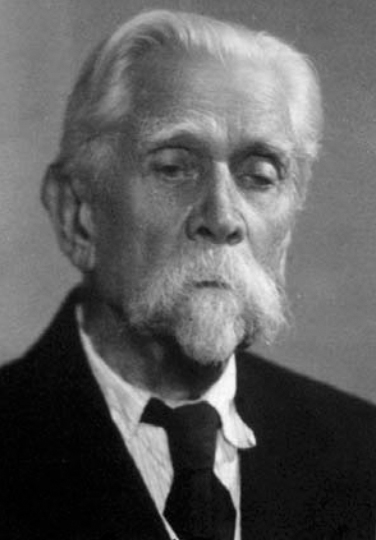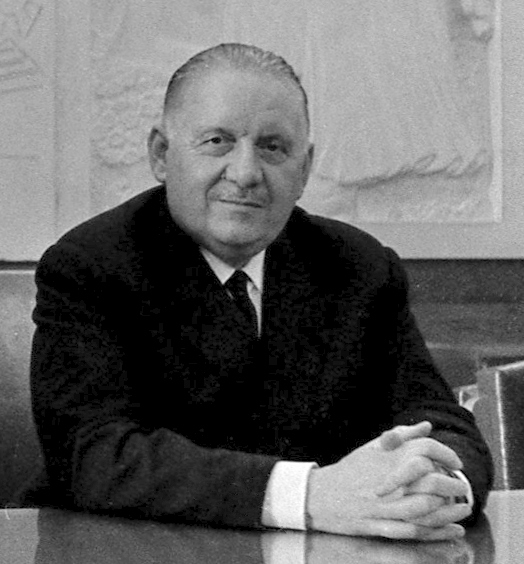|
Kirill Borisovich Tolpygo
Kirill Borisovich Tolpygo ( uk, Кирилo Борисович Толпиго; russian: Кирилл Борисович Толпыго; 3 May 1916 – 13 May 1994) was a Soviet physicist and a corresponding member of the National Academy of Sciences of Ukraine. He was recognized for his works on condensed matter theory; the theory of phonon spectra in crystals; electronic structure and defects in insulators and semiconductors; and biophysics. He created the Department of Theoretical Physics and the Department of Biophysics at Donetsk National University. Tolpygo was a teacher, mentor and scientific adviser to graduate students. Tolpygo was awarded the Order of the Great Patriotic War (2nd Degree). Early life Tolpygo was born during WWI in Kyiv, Ukraine, then part of the Russian Empire. His father, Boris Nikolaevich Tolpygo (1889 – 1958) was a jurist who received the Order of St. Stanislaus for his services to the Russian army during World War I. Tolpygo's mother, Tatiana B. Bu ... [...More Info...] [...Related Items...] OR: [Wikipedia] [Google] [Baidu] |
Soviet Union
The Soviet Union,. officially the Union of Soviet Socialist Republics. (USSR),. was a List of former transcontinental countries#Since 1700, transcontinental country that spanned much of Eurasia from 1922 to 1991. A flagship communist state, it was nominally a Federation, federal union of Republics of the Soviet Union, fifteen national republics; in practice, both Government of the Soviet Union, its government and Economy of the Soviet Union, its economy were highly Soviet-type economic planning, centralized until its final years. It was a one-party state governed by the Communist Party of the Soviet Union, with the city of Moscow serving as its capital as well as that of its largest and most populous republic: the Russian Soviet Federative Socialist Republic, Russian SFSR. Other major cities included Saint Petersburg, Leningrad (Russian SFSR), Kyiv, Kiev (Ukrainian Soviet Socialist Republic, Ukrainian SSR), Minsk (Byelorussian Soviet Socialist Republic, Byelorussian SSR), Tas ... [...More Info...] [...Related Items...] OR: [Wikipedia] [Google] [Baidu] |
Boris Yakovlevich Bukreev
Boris Yakovlevich Bukreev (Russian: –ë–æ—Ä–∏—Å –Ø–∫–æ–≤–ª–µ–≤–∏—á –ë—É–∫—Ä–µ–µ–≤; 6 September 1859 – 2 October 1962) was a Russian and Soviet mathematician who worked in the areas of complex functions and differential equations. He studied Fuchsian functions of rank zero. He was interested in projective and non-Euclidean geometry. He worked on differential invariants and parameters in the theory of surfaces, and also wrote many papers on the history of mathematics. Biography Boris Bukreev was born in Lgov, Kursk Governorate of Russian Empire in the family of a school teacher. His grandfather was also a school teacher. His early education was at home and later he attended a classical Gymnasium at Kursk. In 1878 Bukreev entered St. Vladimir University that at the time was called the University of Saint Vladimir in Kyiv. The university was founded in 1834 and had a very strong school of mathematics. In 1880, Bukreev was awarded a gold medal by the Faculty of Physics and Ma ... [...More Info...] [...Related Items...] OR: [Wikipedia] [Google] [Baidu] |
Emmanuel Rashba
Emmanuel I. Rashba (born October 30, 1927, Kyiv) is a Soviet- American theoretical physicist of Jewish origin who worked in Ukraine, Russia and in the United States. Rashba is known for his contributions to different areas of condensed matter physics and spintronics, especially the Rashba effect in spin physics, and also for the prediction of electric dipole spin resonance (EDSR),E. I. Rashba, Properties of semiconductors with a loop of extrema, I. Cyclotron and combined resonances in a perpendicular field, Sov. Phys. Solid State 2, 1109 (1960). that was widely investigated and became a regular tool for operating electron spins in nanostructures, phase transitions in spin-orbit coupled systems driven by change of the Fermi surface topology, Giant oscillator strength of impurity excitons, and coexistence of free and self-trapped excitons. The principal subject of spintronics is all-electric operation of electron spins, and EDSR was the first phenomenon predicted and experimentally ... [...More Info...] [...Related Items...] OR: [Wikipedia] [Google] [Baidu] |
Atomic Bomb
A nuclear weapon is an explosive device that derives its destructive force from nuclear reactions, either fission (fission bomb) or a combination of fission and fusion reactions ( thermonuclear bomb), producing a nuclear explosion. Both bomb types release large quantities of energy from relatively small amounts of matter. The first test of a fission ("atomic") bomb released an amount of energy approximately equal to . The first thermonuclear ("hydrogen") bomb test released energy approximately equal to . Nuclear bombs have had yields between 10 tons TNT (the W54) and 50 megatons for the Tsar Bomba (see TNT equivalent). A thermonuclear weapon weighing as little as can release energy equal to more than . A nuclear device no larger than a conventional bomb can devastate an entire city by blast, fire, and radiation. Since they are weapons of mass destruction, the proliferation of nuclear weapons is a focus of international relations policy. Nuclear weapons have been deplo ... [...More Info...] [...Related Items...] OR: [Wikipedia] [Google] [Baidu] |
World War II
World War II or the Second World War, often abbreviated as WWII or WW2, was a world war that lasted from 1939 to 1945. It involved the World War II by country, vast majority of the world's countries—including all of the great powers—forming two opposing military alliances: the Allies of World War II, Allies and the Axis powers. World War II was a total war that directly involved more than 100 million Military personnel, personnel from more than 30 countries. The major participants in the war threw their entire economic, industrial, and scientific capabilities behind the war effort, blurring the distinction between civilian and military resources. Air warfare of World War II, Aircraft played a major role in the conflict, enabling the strategic bombing of population centres and deploying the Atomic bombings of Hiroshima and Nagasaki, only two nuclear weapons ever used in war. World War II was by far the List of wars by death toll, deadliest conflict in hu ... [...More Info...] [...Related Items...] OR: [Wikipedia] [Google] [Baidu] |
Red Army
The Workers' and Peasants' Red Army (Russian language, Russian: –Ý–∞–±–æÃÅ—á–µ-–∫—Ä–µ—Å—Ç—å—èÃÅ–Ω—Å–∫–∞—è –ö—Ä–∞ÃÅ—Å–Ω–∞—è –∞—Ä–º–∏—è),) often shortened to the Red Army, was the army and air force of the Russian Soviet Federative Socialist Republic and, after 1922, the Union of Soviet Socialist Republics. The army was established in January 1918. The Bolsheviks raised an army to oppose the military confederations (especially the various groups collectively known as the White Army) of their adversaries during the Russian Civil War. Starting in February 1946, the Red Army, along with the Soviet Navy, embodied the main component of the Soviet Armed Forces; taking the official name of "Soviet Army", until its dissolution in 1991. The Red Army provided the largest land warfare, land force in the Allied victory in the European theatre of World War II, and its Soviet invasion of Manchuria, invasion of Manchuria assisted the unconditional surrender of Empire of Japan, Imperial Japan. ... [...More Info...] [...Related Items...] OR: [Wikipedia] [Google] [Baidu] |
Polaron
A polaron is a quasiparticle used in condensed matter physics to understand the interactions between electrons and atoms in a solid material. The polaron concept was proposed by Lev Landau in 1933 and Solomon Pekar in 1946 to describe an electron moving in a dielectric crystal where the atoms displace from their equilibrium positions to effectively screen the charge of an electron, known as a phonon cloud. This lowers the electron mobility and increases the electron's effective mass. The general concept of a polaron has been extended to describe other interactions between the electrons and ions in metals that result in a bound state, or a lowering of energy compared to the non-interacting system. Major theoretical work has focused on solving Fröhlich and Holstein Hamiltonians. This is still an active field of research to find exact numerical solutions to the case of one or two electrons in a large crystal lattice, and to study the case of many interacting electrons. Experi ... [...More Info...] [...Related Items...] OR: [Wikipedia] [Google] [Baidu] |
Solomon Isaakovich Pekar
Solomon Isaakovich Pekar ( uk, Соломон Ісаакович Пекар; russian: Соломон Исаакович Пекар; 16 March 1917 – 8 July 1985) was a Soviet theoretical physicist, born in Kyiv, Ukraine. He was a full Member of the Ukrainian Academy of Sciences and is known for his fundamental contributions to condensed matter physics, especially for introducing and advancing the concept of polaron as a charge carrier in solids. Career In 1941 Pekar submitted his Candidate of Science thesis on nonlinear theory of semiconductor rectifiers for which he was awarded Doctor of Science Degree, this work was strongly approved by Lev Landau. In 1946, Pekar developed a concept of a polaron and coined this term. The model developed in this paper is macroscopic and based on electrostatic coupling of an electron to polar optical phonons. This coupling results in dressing of the electron by a cloud of virtual phonons and renormalization of its energy spectrum. In the s ... [...More Info...] [...Related Items...] OR: [Wikipedia] [Google] [Baidu] |
Institute Of Physics Of The National Academy Of Sciences Of Ukraine
The Institute of Physics (IOP) of the National Academy of Sciences of Ukraine ( uk, –Ü–Ω—Å—Ç–∏—Ç—É—Ç —Ñ—ñ–∑–∏–∫–∏ –ù–∞—Ü—ñ–æ–Ω–∞–ª—å–Ω–æ—ó –∞–∫–∞–¥–µ–º—ñ—ó –Ω–∞—É–∫ –£–∫—Ä–∞—ó–Ω–∏) founded in 1926 is the oldest research institution of physical science within the academy. Being on the path of both infrastructure development and research diversification for more than 80 years, the institute has eventually originated five more specialized research institutions. Currently, the institute employs more than 300 researchers (together with two full members and eight corresponding members of the NASU) and around 200 peoples of supporting personnel. It has more than 20 scientific units (including the state-of-the-art Femtosecond Laser Complex) which are grouped around four research programs Traditionally, the institute is focused on fundamental research. At the same time, applied research on cryogenics, LC displays, laser systems, pyroelectric detectors, biophysics and plasma technologies s ... [...More Info...] [...Related Items...] OR: [Wikipedia] [Google] [Baidu] |
Kyiv University
Kyiv University or Shevchenko University or officially the Taras Shevchenko National University of Kyiv ( uk, –ö–∏—ó–≤—Å—å–∫–∏–π –Ω–∞—Ü—ñ–æ–Ω–∞–ª—å–Ω–∏–π —É–Ω—ñ–≤–µ—Ä—Å–∏—Ç–µ—Ç —ñ–º–µ–Ω—ñ –¢–∞—Ä–∞—Å–∞ –®–µ–≤—á–µ–Ω–∫–∞), colloquially known as KNU, is located in Kyiv, the capital of Ukraine. The university is universally recognized as the most prestigious university of Ukraine, being the largest national higher education institution. KNU is ranked within top 650 universities in the world. It is the third oldest university in Ukraine after the University of Lviv and University of Kharkiv. Currently, its structure consists of fifteen faculties (academic departments) and five institutes. It was founded in 1834 by the Russian Tsar Nikolai I as the Saint Vladimir Imperial University of Kiev, and since then it has changed its name several times. During the Soviet Union era, Kiev State University was one of the top-three universities in the USSR, along with Moscow State University and L ... [...More Info...] [...Related Items...] OR: [Wikipedia] [Google] [Baidu] |
President Of France
The president of France, officially the president of the French Republic (french: Président de la République française), is the executive head of state of France, and the commander-in-chief of the French Armed Forces. As the presidency is the supreme magistracy of the country, the position is the highest office in France. The powers, functions and duties of prior presidential offices, in addition to their relation with the prime minister and Government of France, have over time differed with the various constitutional documents since the Second Republic. The president of the French Republic is the '' ex officio'' co-prince of Andorra, grand master of the Legion of Honour and of the National Order of Merit. The officeholder is also honorary proto-canon of the Archbasilica of Saint John Lateran in Rome, although some have rejected the title in the past. The incumbent is Emmanuel Macron, who succeeded François Hollande on 14 May 2017, and was inaugurated for a se ... [...More Info...] [...Related Items...] OR: [Wikipedia] [Google] [Baidu] |






